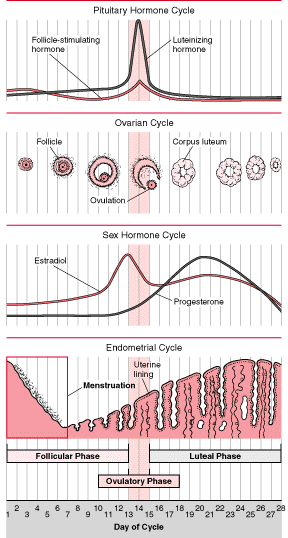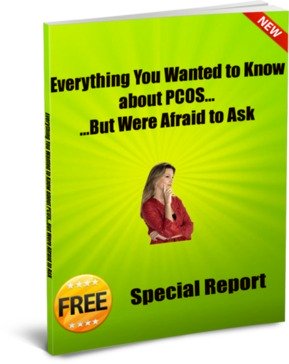Normal Menstrual Cycle
1. At the start of your cycle, the hypothalamus gland, located in the brain, secretes gonadotropin-releasing hormone (GnRH). This hormone travels to the pituitary gland, near the hypothalamus. GnRH stimulates the pituitary to release both luteinizing hormone (LH) and follicle-stimulating hormone (FSH).
2. FSH travels to the ovaries. The increased level of FSH causes the growth of follicles on your ovaries. A follicle is a fluid-filled sac that contains an egg. Normally, one of them will become dominant, sometime during day 4-7 of your cycle.
3. The dominant follicle, a structure containing the egg, is surrounded by flattened follicular cells called granulosa cells. FSH stimulates an increase in their size and numbers. These granulosa cells then release estradiol, one of the three important estrogens in your body, which acts upon the hypothalamus to continue secreting GnRH, a self-perpetuating mechanism. Once the follicle is mature, it is called a Graafian follicle.
4. At around day 14 of the cycle, LH and FSH reach their peak
levels. This is called the "LH surge". LH acts on the follicle to
increase production of fluid, which leads to release of the egg
into the peritoneal cavity. This is ovulation.

5. After the follicle has burst and released its egg, it starts to refill with fluid. The increased level of LH causes the fluid to transform into a thick yellowish substance. The follicle has now become a different structure, called the corpus luteum.
The remaining granulosa cells undergo a chemical transformation called luteinization. During this process, the granulosa cells increase in size and number. These cells, now called the corpus luteum, are responsible for secreting large amount of progesterone, and to a lesser degree, estrogen; both of which now inhibit the release of GnRH.
6. The corpus luteum produces progesterone for about 12 days during the second half of your menstrual cycle. Progesterone causes the lining of your uterus to thicken and stimulates development of blood vessels so that your fertilized embryo will have a supportive place to implant and start growing.
The corpus luteum increases in size for another 7-8 days, and then begins degeneration if pregnancy does not occur.
7. The degeneration of these cells results in the formation of the corpus albicans and ends the production of estrogen and progesterone, which triggers the shedding of the unneeded lining of your uterus. This is your menses and your menstrual cycle starts all over again.
Return to Miscarriage and PCOS Page
PCOS Health Review
This free newsletter gives you original and immediately usable information to help you deal with PCOS.
Get the latest research, tips for improving your health, answers to questions, success stories, and more!
Your e-mail address is totally secure. We will never misuse your information.
Enter Your Email Above to Subscribe Today
and Get Your Questions Answered in this Free Special Report!





